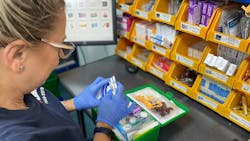Aeromedic/AMETEK MRO Responds to New Requirements for Onboard Medical Equipment
According to Steve Rowley, engineering director at Aeromedic, changes to commercial air transport regulations globally have resulted in airlines needing to review and update their onboard medical provisions.
Rowley says, “I believe that airlines will increasingly look towards adopting new technology, with real-time telemedicine capabilities that can connect passengers and crew with remote medical experts and diagnostic tools in case of an emergency, such as mobile ECGs. Critical conditions can be accurately identified, avoiding the need for emergency landings and the significant cost and passenger inconvenience that ensues.”
In Europe, the CAA and EASA mandate that airlines must have kits on board every aircraft, and the number of kits required depends on the size of the aircraft.
“Airline cabin crews receive enhanced first aid training and will be fully aware of the kit contents and provisions available onboard their airline’s fleet,” says Rowley.
Rowley adds, “However, in addition to first aid kits (FAKs) and emergency medical kits (EMKs), Aeromedic manufactures a range of niche, specialist on board medical kits including universal precaution kits (UPKs) which are used in response to infectious disease on board, and emergency resuscitation kits (ERKs) make up further regulatory conformance. The scope is broad – from plasters and Calpol to ampoule trays and other medical devices – there are dozens of kit variants, and we use our expertise to help airlines and operators of all sizes navigate their way through this vital, but difficult, area. Aligning equipment capabilities to crew training and telemedic guidance opens a new area of onboard specification complexity.”
The changes, spearheaded by EASA, have been adopted worldwide and include an increase in the minimum mandatory medicine and medical equipment provisions airlines must carry onboard. Resuscitation equipment, pediatric forms of medicine and the addition of pulse oximeters are a few examples of a broader spectrum of in-flight kit.
Aeromedic has a specialist combination of pharmaceutical/medical and aviation accreditations and can manage the design, sourcing, manufacture and supply of first aid and medical kits on a large scale.
“In the commercial airline sector, our customers include leading European national carriers and low cost airlines,” says Rowley, “Each of these has bespoke kit contents that are defined by regulations, medical training protocols, base-station supply practices and much more.”
Many airlines need assistance undertaking this requirement due to global compliance monitoring. Airlines that operate worldwide need to be reassured they are compliant everywhere.
Aeromedic can provide airlines with kits containing all the mandatory requirements, while being lightweight, accessible and easy to use in an emergency. The team is experienced in the control and logistics of kits, especially those subject to the import and export of controlled drugs across global jurisdictions.
Aeromedic is authorized by the home office for the possession and supply of controlled drugs. It sources these drugs in bulk and repackages in small quantities for the kits. This work is supervised and approved by a qualified medical professional.
“Aeromedic’s bespoke kit processing software tracks the expiry date and batch number of hundreds of thousands of components every month,” explains Rowley.
Rowley adds, “Strict recycling protocols are followed during kit refurbishment processes, meaning that all unused items with sufficient shelf life remain in the kits. Some airlines refurbish immediately a kit is opened; others have tamper-evident seals installed to keep the contents safe for multiple flights. Yet more have minimum equipment lists that need to be maintained."
"Every customer is different, however with increasing regulation and mandatory requirements, telemedicine technologies will be a game-changer in such a complex global environment. If airlines can harness technology, supported by crew training and carefully curated onboard medical kits and equipment, unnecessary and expensive diversions can be avoided, and the safety, well-being, and peace of mind of every passenger will be improved,” says Rowley.
